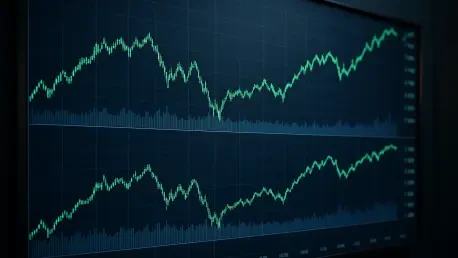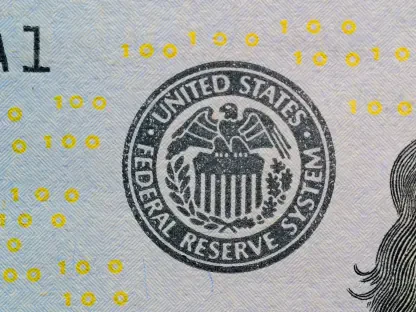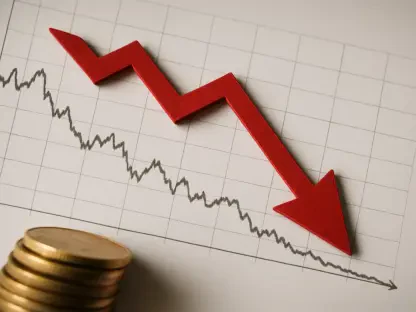On a remarkable day for the U.S. stock market, the S&P 500 achieved a historic milestone by closing above 6,400 for the first time on August 12, marking a significant moment of triumph for investors across Wall Street. This unprecedented surge reflects a powerful wave of optimism driven by encouraging economic data and mounting expectations for Federal Reserve intervention to ease monetary policy. The rally extended beyond just one index, with other major benchmarks like the Dow Jones Industrial Average, Nasdaq Composite, and Russell 2000 also posting impressive gains, signaling a broad-based confidence in the market’s trajectory. What lies behind this extraordinary performance is a blend of cooling inflation signals and the near-certain anticipation of interest rate cuts, painting a picture of a market buoyed by hope and strategic policy expectations. This achievement is not merely a numerical benchmark but a testament to the resilience and dynamism of the current economic landscape, setting the stage for a deeper exploration of the factors fueling this historic rally.
Market Surge Signals Broad Optimism
The breakthrough of the S&P 500 above the 6,400 threshold stands as a powerful symbol of a robust market rally that has been gaining momentum over recent months. This record close, alongside all-time highs for the Nasdaq Composite, reflects a shared belief among investors that favorable conditions are aligning for sustained growth. The Dow Jones Industrial Average also joined the upward trend with a notable increase of approximately 1.1%, translating to nearly 500 points, while the small-cap Russell 2000 index surged by almost 3%. Such widespread gains across diverse segments of the market underscore a bullish sentiment that transcends specific sectors, hinting at a collective faith in the economy’s direction. This rally is not just about numbers on a chart; it represents a significant vote of confidence from investors in the stability and potential of the financial system.
Further illustrating the depth of this market surge, the performance of small-cap stocks, often viewed as a gauge of broader economic health, reveals an encouraging narrative. The nearly 3% jump in the Russell 2000 suggests that optimism is not confined to large corporations but is also lifting smaller companies, which are typically more sensitive to domestic economic shifts. Unlike previous rallies that may have been driven by a narrow set of heavyweight stocks, this broad-based advance indicates a healthier, more inclusive growth pattern. Investors appear to be betting on a wide array of opportunities, from established giants to emerging players, as they position their portfolios for what many anticipate will be a supportive policy environment in the near term. This comprehensive strength across indices highlights the pervasive nature of the current market enthusiasm.
Inflation Report Sparks Policy Hopes
A pivotal driver behind the recent market euphoria stems from the latest inflation data released by the Bureau of Labor Statistics, which has provided a critical boost to investor sentiment. The July Consumer Price Index (CPI) report indicated that headline inflation held steady at 2.7% year-over-year, a figure slightly below the consensus forecast of 2.8%. This subtle but meaningful deviation suggests that price pressures may be cooling, offering a glimmer of relief in an economic climate often marked by persistent cost increases. Such data has fueled speculation that the Federal Reserve might have more room to maneuver in adjusting monetary policy, a prospect that has invigorated markets hungry for lower borrowing costs. The implications of this report extend beyond mere statistics, shaping expectations for future economic stability.
However, the inflation story is not without its complexities, as deeper layers of the data reveal lingering challenges. Core inflation, which excludes the volatile categories of food and energy, rose to 3.1% annually, up from 2.9% in the previous month. This uptick points to underlying price pressures that continue to simmer in certain sectors, potentially complicating the narrative of a straightforward path to monetary easing. While the headline figure offers a dovish signal, the core inflation increase introduces a note of caution, reminding investors that not all inflationary trends are moving in the same direction. As markets digest this mixed picture, attention turns to additional economic indicators, such as upcoming retail sales and Producer Price Index reports, which could further clarify the economic landscape and influence policy expectations.
Rate Cut Expectations Drive Momentum
The inflation report has significantly amplified anticipation for a Federal Reserve interest rate cut, with markets now placing a high probability on action as early as September. Data from the CME FedWatch Tool shows that approximately 94% of traders are betting on a reduction in borrowing costs, a near-universal expectation that has acted as a powerful catalyst for the current rally. This surge in confidence is particularly evident in interest-rate-sensitive sectors, such as small-cap stocks, which have benefited from the prospect of cheaper financing. Analysts suggest that such a policy shift could provide a substantial lift to economic activity, reinforcing the bullish momentum that has propelled indices to record levels. The market’s reaction underscores the critical role of central bank policy in shaping investor behavior.
Debates among market participants and experts continue regarding the potential scale of the anticipated rate adjustment, adding a layer of intrigue to the unfolding narrative. While some, including Renaissance Macro’s Neil Dutta, argue that the softer headline inflation data virtually guarantees a cut in September, others speculate on the possibility of a more aggressive easing, potentially totaling three-quarters of a percentage point by the end of the year. This range of opinions reflects the uncertainty surrounding the Federal Reserve’s balancing act between curbing inflation and supporting growth. As traders position themselves for various outcomes, the consensus remains that any reduction in rates will likely sustain the market’s upward trajectory, particularly for sectors poised to capitalize on lower interest expenses. This dynamic keeps the spotlight firmly on upcoming Fed communications for further clarity.
Technology Sector Powers the Rally
Leading the charge in the S&P 500’s historic ascent is the technology sector, which continues to serve as the primary engine of market gains. Large-cap tech stocks, especially those with strong ties to artificial intelligence, have significantly outperformed the broader index, with companies like Nvidia, Microsoft, and Apple setting the pace. The top 20 market cap stocks have shown remarkable growth, far exceeding the overall S&P 500’s performance, a trend that highlights the concentrated strength within this innovative segment. This dominance is not merely a fleeting phenomenon but a reflection of deep investor faith in technology’s transformative potential to drive economic progress, making it a cornerstone of the current bull market.
A closer look at individual performers within the tech space reveals the scale of this impact, with Meta Platforms standing out as a prime example. The company saw its stock rise by 3.5%, pushing it closer to a staggering $2 trillion market capitalization, fueled by robust earnings and rapid growth in its social media platform Threads. Other tech giants are similarly benefiting from a wave of enthusiasm for AI-driven solutions, which are increasingly seen as critical to future profitability across industries. This sector’s ability to consistently deliver outsized returns has cemented its role as a market leader, drawing substantial capital inflows from both institutional and retail investors. As technology continues to shape investment priorities, its influence on the broader rally remains undeniable, promising further upside if innovation maintains its current pace.
Political Influences Stir Market Dynamics
Beyond economic indicators, political developments are exerting a notable influence on market movements, adding a unique dimension to the current rally. President Trump’s tariff policies have generated a record $27.7 billion in customs duties for July, significantly altering the trade landscape and contributing to government revenue while sparking debates over their impact on inflation and consumer costs. Such measures have introduced both opportunities and uncertainties for businesses, with some sectors facing higher input costs while others benefit from protective barriers. This policy-driven shift is a reminder of how executive actions can directly affect market sentiment, often with ripple effects that extend across global economies.
Additional political maneuvers are also shaping specific sectors, demonstrating the intersection of governance and finance. The nomination of new leadership at the Bureau of Labor Statistics and discussions around reclassifying marijuana as a Schedule III drug have created targeted market reactions, with cannabis stocks like Tilray jumping 10% in premarket trading on the latter news. These policy signals highlight the potential for rapid shifts in investor focus, as regulatory changes can unlock new growth avenues or impose unforeseen challenges. The interplay between political decisions and market outcomes remains a critical factor to monitor, as it adds a layer of unpredictability to an otherwise data-driven rally. This dynamic ensures that investors must stay attuned to both economic fundamentals and the evolving political landscape.
Global Trends Mirror U.S. Market Strength
The optimism propelling the U.S. stock market is not an isolated phenomenon, as international markets are also experiencing synchronized strength, reflecting a global wave of confidence. Japan’s Nikkei 225, for instance, recently hit a record high, driven by reduced fears over U.S. tariffs and a tech sector rally led by companies like Micron Technology. This parallel surge suggests that positive sentiment is crossing borders, fueled by interconnected economic policies and shared technological advancements. As global investors respond to similar catalysts, such as anticipated monetary easing and innovation-driven growth, the alignment of market trends underscores the interconnected nature of today’s financial systems.
Domestically, broader economic trends are also influencing the narrative, with small business optimism showing signs of recovery according to reports from the National Federation of Independent Business. However, lingering concerns over tariffs, inflation, and geopolitical tensions continue to temper this positivity, particularly among smaller enterprises more vulnerable to policy shifts. Meanwhile, cryptocurrency-related stocks are riding a separate but related wave, with firms like Bitmine Immersion Technologies planning significant expansions as Ethereum prices climb. These diverse yet interconnected trends highlight the multifaceted drivers behind the current market environment, where global and local forces converge to shape investor expectations. The interplay of these elements suggests a complex but broadly supportive backdrop for equity markets worldwide.
Sustained Investor Faith Fuels Gains
Investor behavior is playing a crucial role in sustaining the momentum of this historic rally, with both retail and institutional participants demonstrating remarkable confidence in the market’s direction. Data from Bank of America reveals significant inflows into large-cap tech stocks, marking the largest weekly single-stock investments in two years. This trend of buying into dips indicates a belief that current valuations, particularly in high-growth sectors, remain attractive despite periodic volatility. Such robust capital deployment reflects a strategic optimism, where market participants are willing to weather short-term fluctuations for long-term gains, especially in areas tied to technological innovation.
This sustained faith is particularly pronounced in sectors like technology and AI, where the promise of future disruption continues to draw substantial interest. The enthusiasm is not without caveats, as upcoming economic reports and Federal Reserve decisions could introduce new variables into the equation. Nevertheless, the current mood on Wall Street remains unmistakably upbeat, with the record close of the S&P 500 serving as tangible evidence of this sentiment. As investors maintain their bullish stance, the market’s ability to absorb potential shocks will likely depend on the clarity of forthcoming data and policy signals. For now, the combination of strong inflows and a favorable outlook suggests that the rally has the potential to persist, provided external conditions remain conducive to growth.
Reflecting on a Milestone Moment
Looking back, the S&P 500’s climb above 6,400 on August 12 marked a defining moment for the U.S. stock market, encapsulating a period of extraordinary optimism driven by economic data and policy expectations. The widespread gains across major indices, fueled by cooling inflation signals and near-certain anticipation of Federal Reserve rate cuts, painted a picture of a market in robust health. Technology stocks, political developments, and global trends all played integral roles in shaping this historic achievement, reflecting the complex interplay of forces at work.
Moving forward, the focus shifts to sustaining this momentum through careful navigation of upcoming economic indicators and central bank actions. Investors would benefit from closely monitoring inflation reports, retail sales data, and Federal Reserve communications to gauge the durability of the current rally. Additionally, staying attuned to political and global developments will be crucial, as these factors can swiftly alter market dynamics. As the financial landscape continues to evolve, maintaining a balanced approach to risk and opportunity will be key to capitalizing on the gains achieved during this remarkable period of market history.









